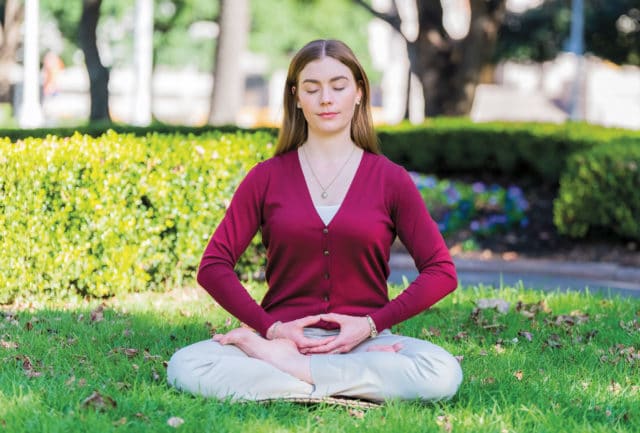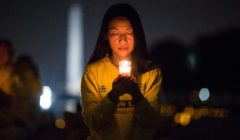Transcending the Mundane
Falun Gong and the age-old Chinese belief behind it

It is an idea with staying power. A belief as old as Chinese civilization itself, having resonated with a stunning range of dynasties, provinces, and personalities. To generations has it spoken. In the very substrate of China’s culture is it firmly embedded.
The idea has, if not moved mountains, at least ennobled them: China’s celebrated “Five Sacred Peaks” were christened as such for their connection to this idea. It was a defining pursuit in the life of Wang Wei, one of China’s most beloved and celebrated Tang poets, as it was in that of the reputed founder of China’s fabled Shaolin Monastery, Bodhidharma.
And today the idea lives on in important ways, as seen in the Falun Gong phenomenon, where it is a central component. I would even argue Falun Gong can’t be understood in its absence.
The idea is this: that a human being can, through disciplined spiritual practice, transcend this ordinary existence. A higher state of being is envisioned, one having its own privileged joys and knowledge. In the Chinese model the ingredients of this transformation have primarily been a life that is morally robust and the use of special meditative exercises. The successful disciple of these arts is called variously “a transcendent,” “one who has attained the Tao,” “an Enlightened one,” or more commonly, “an Immortal.”
As early as the 4th century BC, the traits of the transcendent were taking form. It was perhaps Zhuangzi, the playful Taoist philosopher, who first wrote of such figures. In one of his best known passages, he tells of how “on Miao-ku-yi Mountain there lives a divine one, whose skin is white like ice or snow, whose grace and elegance are like those of a virgin, who eats no grain but lives on air and dew, and who, riding on clouds with flying dragons for his team, roams beyond the limits of the mortal regions.” This higher state, the text seems to insist, is not to be read as fiction or fantasy, but as a prospect.
By the time of the Han Dynasty a couple of centuries later, the image of the Immortal was firming up and in increasingly wide circulation; the possibility was now held out, as it were, that human and heavenly qualities were not altogether separate, the goods of different realms; rather, they existed on a continuum. Most importantly, there were methods to cultivating the latter. Programs existed.
Means and Ends
This idealized entity, which we’ll call the Transcendent for simplicity, has from his (or occasionally “her”) inception been marked and made by his physicality. That is, just as it has long been certain physical traits (e.g., radiant health or relics) that signify some form of higher spiritual attainment in the Chinese tradition, similarly it has been physical means that secure them.
One leading scholar of Chinese religion, Livia Kohn, has explained that in the Chinese tradition, “Physical exercises are the first active step taken toward the Tao [or “Way”]. They serve to make the body healthy, to extend its lifespan, and to open it up to the free flow of the Tao.” China’s Taoists have thus for centuries made the body “the basis, the root, the foundation of the cultivation process, [a way to] anchor oneself in physicality and transform the very nature of bodily existence as part of the divine undertaking.”
Put another way, the idea of a mind-body connection is old news in the Chinese context. Scholars such as Russel Kirkland have aptly dubbed this approach to self-transformation “biospiritual cultivation.”
To this end, a rich host of physical-spiritual disciplines have been developed over the centuries in China. Generally these practices have involved controlled breathing, special diets and fasting, visualization, medicinal drugs, and gymnastics-like exercises (called by many “Chinese yoga”). Any program involving these is thought to recalibrate, as it were, the invisible landscape of the body. The body in this worldview is seen as an amalgam of vital forces and essences, the disequilibrium of which, or compromised circulation of, leads to illness.
At their simplest, then, programs of proper breathing and diet could bring the movement of subtle bodily energies into balance, ensuring good health. They also readily found application in other arenas, such as the martial arts, archery, and even calligraphy or landscape painting.
But applied in a more focused manner, and for higher ends, these were the very fodder for self-actualization and biospiritual transformation. Such efforts are generally referred to by scholars as “self-cultivation,” or simply “cultivation,” for short. In their fullest, they often combine physical discipline with moral rectitude of the strictest order. Kohn writes that, “cultivation means action and forward motion, progress and enhancement. Once begun, it is a continuous process, an ongoing movement of transformation. It requires that one challenges basic assumptions about self and world, becomes a new person with every phase, and is never quite satisfied, done, or finished. There is always the divine ideal looming above…”
Such approaches, grounded in the locus of the body, could be contrasted with the more “devotional” traditions familiar to us in the West. There the body, in all its carnal and cavorting ways, is more burden than boon. It stands between oneself and spiritual realization, rather than being grist for the latter.
This is not to say, of course, that the mind or spirit was not essential in the Chinese aspirant’s work of self-cultivation. Indeed, the severing of desires, the clearing out of attachments, defilements, and other spiritual clutter, have long been critical ingredients; the ability to restrain one’s thoughts and desires has been fundamental in this process. Moral self-mastery is indeed often fundamental. Cleanliness here too is close to godliness.
Rather, for the Taoist and many others, the two oft went hand in hand. As the famous 7th century physician Sun Simiao once wrote, “If you wish to calm the spirit, first refine the primordial energy. When this energy resides in the body, spirit is calm and energy is like an ocean. With the ocean of energy full to overflowing, the mind is calm and the spirit stable.”
Discipline and Caves
With all due respect to Denise Austin, this was not “Yoga Buns,” to be sure. The level of discipline and commitment such practices took when directed toward higher, spiritual ends, was so drastic as to exclude most all but the privileged elite of traditional China. The demands made upon one’s time, resources, and—perhaps most of all—willpower, would be enough to make even today’s most extreme of athletes shudder.
Consider how some old-time aspirants gave a whole new meaning to “do or die.” The person would climb into a cliff-side cave with the help of a rope, only to then cut the rope, determined to either cultivate to enlightenment or perish—slowly and certainly hungrily—trying. Others took often-toxic alchemical potions, knowing their risks. These were not escapists, however, but people intensely devoted to confronting the most pressing facet of reality they knew: the human condition. Mortality was not so much a given, as a challenge.
The image of a carefree Taoism and warm-fuzzy Buddhism, popular in the West, belie this fact. According to Kirkland, this has to do with a series of botches. Taoism and similar Eastern spiritual arts were “deeply misunderstood” and “falsely imagined” in the West, he claims. Narcissistic, commercially minded folk have misrepresented such practices as teaching “going with the flow” and “just being spontaneous.” Indeed, books purportedly on Taoism and Zen often read remarkably like “Chicken Soup for the Soul.” The result is a growing literature on Taoism and its kin that amount to “mindless fluff,” in Kirkland’s opinion.
“In Taoism, achieving the spiritual goal has never been something that happens ‘spontaneously,’” Kirkland says, but “rather, it emerges out of a demanding personal process, which requires work, dedication, and a sacrifice of self-centeredness.”
The goal of such practices was “to attain an exalted state of existence through diligent cultivation of the world’s deeper realities,” according to Kirkland, and not, thus, stress relief, a good night’s sleep, or trim abs, though these might be byproducts of the practice. “Such attainments were generally predicated upon a process of personal purification and an enhanced awareness of reality—i.e., a process of moral, spiritual, and cognitive growth.”
Another scholar, Akira Akahori, echoes this appraisal, both in terms of the means and their fruits. He writes that, traditionally, “One can only become immortal by being singularly dedicated to the work, renouncing the common world completely, and being fearless even in the face of death.” This often meant, in practice, hours of dedicated practice each day. Some adepts would perform their gymnastics and meditations for more than a dozen hours a day, atop the study of scriptures and consumption of carefully concocted foods and medicinals. Such programs, practically speaking, could only be undertaken in a monastic setting or the isolation of a mountain hermitage or cave. Just one disruption at the wrong time could prove disastrous.
The promise, then? “Utter freedom of body and mind is the ultimate reward, an immortality equal to that of heaven and earth,” according to Akira.
Into the Parks
In 1980s China, shortly after the death of Mao, all of this would give way more or less to a new incarnation of the classical pursuit. This was to be a modern version of immortality, complete with all the trappings of progress—scientific credentialing, State approval, and available to the masses. It was almost the complete inverse of the private, religious, elite pursuit of immortality. For this, the qigong craze was thoroughly public, secular, and mundane.
“Qigong” (literally, “working qi-energy”) was the term fashioned for this new version of biospiritual cultivation. Coined in 1951, the very name suggested a break with the past: The emphasis was now on qi, a quasi-material form of energy, and the health it could bring; the intangible spiritual goals of yore were a sort of embarrassing, or at least problematic, remnant, branded by many as “superstition.”
In the words of the Japanese scholar Kunio Miura, in this era “the average qigong practitioner would not … connect any spiritual aims with the techniques. Good for health and therefore for the family and fatherland, fun to do and a nice way to meet people informally. A new sport for the masses—that’s what it seems to boil down to.” Call it Yoga Buns, Chinese style.
What is important to note here is that this domestication of a once rough, demanding, and quixotic pursuit meant for the first time that the general public could taste of its fruits, even if not of its highest ideals. In other words, the pleasant health benefits of Chinese gymnastics and their ilk were remarkably accessible now. By the break of dawn, indeed, most every inch of China’s parks would by the late 1980s be filled with qigong and tai-chi enthusiasts. Some 2,000-plus forms of qigong were reportedly being practiced, with over 200 million daily participants. “Qigong Masters,” as they were called, came forth in droves during this period, offering what were previously private lineages of transmission. In Chinese parlance, they “came forth from the mountains.” For many, their remarkable feats of strength, healing, and magical powers cast them as transcendents in their own right. Whatever the case, qigong, in granting health, gave millions a taste of things greater: by changing the course of illness, one could change destiny.
Enter Falun Gong
It is in this context, transcendence past and present, that we place Falun Gong. Few analyses have done so, surprisingly, despite a burgeoning body of scholarship on Falun Gong and qigong. The focus thus far has been largely at the social level, or, if historical, focused on the group level and in terms of movements.
But for the many members of Falun Gong I have spoken with in Beijing, Taiwan, and North America, the practice is first and foremost a deeply personal affair, and only secondly, if at that, a social thing. This wasn’t another “nice way to meet people” or a healthy “sport,” as post-Mao qigong had become for China’s masses. It was, rather, a movement inwards, a deepening that reached toward the infinite; “inward cultivation” many call it. For many, the practice introduced them to an inner world—that of one’s own mind. It was a taste of something greater, even divine.
In Falun Gong, many found the transcendent ideal rekindled. Combining both the bodily and spiritual in a disciplined program of Buddhist self-cultivation, Falun Gong’s approach to perfection was a throwback. A 6th century Chinese monastic would have been at home with the practice.
For the majority of adherents, certainly health benefits served as an entrée; many took up the practice on account of aches and ailments. Word got out early that Falun Gong was unusually “effective,” and efficacy, more than anything, was what had come to decide success or failure for qigong. Even the Chinese state weighed in, such as when the People’s Public Security News, a publication of the Ministry of Public Security, praised Falun Gong’s founder for giving qigong healings to disabled crimefighters. The publication declared that, “After the treatments, they unanimously agreed upon their amazing improvements.”
What has proved defining is that in Falun Gong health is not an end in itself, as in most if not all other qigong forms, but rather a byproduct along the path of biospiritual cultivation; at best, it might be a means to an end. Healing in contemporary Chinese qigong has after all been largely a secular, disenchanted thing—the stuff of qi.
In Falun Gong, by contrast, the “message is profoundly moral” according to David Ownby, a historian of Chinese religion who has written extensively on Falun Gong. Indeed, one’s moral state is understood here to inform wellness or its absence; debts of wrongdoing, or “karma” in the Chinese vocabulary, translate into suffering or misfortune. As in the early Taoist communities, physical health is ultimately a statement having to do with one’s overall moral and spiritual state.
The positive bodily effects of Falun Gong have translated, many tell, into a spiritual epiphany of sorts: that there is something more, a beyond. Beyond qi and bodily conduits are much larger and deeper things. Cosmic laws are here every bit as real as flesh and blood, and as such, can be studied as one would a science and even be abided by. The promise is, as in days of yore, far-reaching: transformation of the bodily-spiritual self, or even “enlightenment.”
With Falun Gong, however, the offer is extended to all. It has always been made accessible and immediate, asking only the individual’s willingness to invest effort in his or her own personal growth. The practice has always made its teachings available for free online, and attached no conditions to their study (e.g., age, fitness level, fees).
Ownby has remarked that, “when you talk to Falun Gong practitioners, over and over and over again they come back to the notion of being good, that the universe itself is good … what I have found when I talk to people is that there is [for them] a great pleasure in being able to devote oneself to being good.”
I believe this bespeaks of what might be called the joys of self-discipline. In the quest for self-mastery that China’s religious aspirants have narrated so well, there is more than pain and peril. To be able to sit, legs crossed in “full-lotus” position for an hour is a physical feat, and one requiring a certain form of mastery; it’s one the Falun Gong enact daily. Similarly, there is the self-restraint practiced—the harnessing of wild, once undetected thoughts and desires. If we are to believe Sun Simiao and others, with such mastery comes an “ocean of energy full to overflowing.” I find the claim to ring true, having sampled these arts. Inner stillness, as with self-control, amounts to a kind of subtle joy that may be worn as a smile, but perhaps never fully expressed.
For many then, “doing” Falun Gong amounts to a form of positively becoming, a process of assimilating to higher laws of nature and cosmos (summarized as “truth,” “compassion,” “tolerance”) and a cleansing of body just as of soul. It is in this light that so many of the group’s activities in the face of state-suppression become intelligible—the disciplined response, the patience, the optimism, the dogged tenacity. These are people who daily imbibe of other realms. They are people who feel, by their account, nothing short of the cosmos coursing through their veins. Theirs is a grounding of a different sort, not likely to be supplanted by the whims of the day.
This then is a sensibility, an orientation, that runs through and undergirds so much of Chinese culture. If history is any indicator, it is here to stay. Some ideas are transcendent.
Matthew Kutolowski is a Ph.D. candidate at Columbia University studying Chinese religion and culture.






